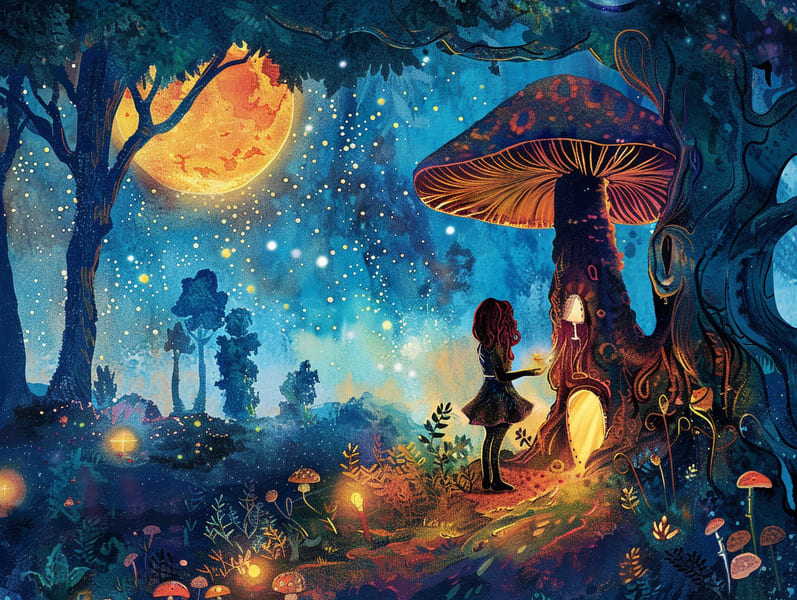
Popular fairy tales have deep roots. These stories have been relayed from one generation to the next well before they were ever put on paper. They sprang from a variety of civilizations, including American traditions. They were initially conveyed among adults, often carrying themes and messages relevant to the societal norms and beliefs of the time.
The renowned Brothers Grimm, Jacob and Wilhelm, were among the first to gather many of these beloved tales. Their collection, "Grimm's Fairy Tales," included classics like "Ashenputtel," "The Bread Crumb Trail," and "Snow White," which have since become cornerstones in the world of traditional fairy tales. Similarly, Hans Andersen's whimsical narratives, such as "The Story of the Little Mermaid," and "The Duckling's Story," have floated into hearts worldwide, establishing their place in the pantheon of beloved fairy tales.
Though they are centuries old, classic fairy tales remain as relevant as ever, especially as children's bedtime stories. These enchanting tales are now available in different formats, including gorgeously illustrated books, charming animations, and web-based fairy tales.
Their continued relevance can be credited to several enchanting factors:
Life Lessons: Timeless fairy tales often whisper important moral lessons. Narratives like "The Tale of the Boy Who Cried Wolf" teach the virtue of sincerity, while "The Tale of the Tortoise and the Hare" demonstrate the benefits of perseverance and meekness. These stories offer little ones clear distinctions between correct and incorrect, molding their moral compass in a soft yet deep way.
Empathy and Understanding: Classic fairy tales frequently depict figures facing trials and tribulations, urging children to feel with their struggles and boost their triumphs. For instance, "The Story of Beauty and the Beast" reveals the significance of looking beyond appearances to perceive the inner core of a person, building understanding and knowledge.
Cultural Appreciation: Many traditional fairy tales are rooted in the cultural contexts from which they developed. Understanding these stories can provide intriguing perspectives into different heritages, encouraging a sense of international awareness and recognition.
Fantasy and Innovation: The whimsical elements in old fairy tales—magical beings—enhance children’s imaginative ideas. These stories guide readers to magical realms, inspiring inventive thinking and a sense of delight that continues a lifetime.
Ancient fairy tales are not only captivating but also didactic. They serve as magical tools in cultivating various brain and heart skills in kids. When classic fairy tales are recited, they strengthen speaking abilities by bringing new terms and meanings and intricate sentence structures. This practice also advances listening abilities and mental focus, as kids stay focused, ready to see what happens next.
Furthermore, talking about the themes and characters of traditional fairy tales can promote evaluative skills and reasoning skills. The young are educated to recognize patterns, make predictions, and figure out cause and effect. These explorations also advance kids express their thoughts and feelings, fostering their emotional intelligence.
In today’s electronic age, the proliferation of online fairy tales has made these narratives more reachable than ever. Online resources and software make available wide arrays of popular fairy tales that can be accessed or listened to anytime, anywhere. Fairy tales narrated are particularly liked, giving an charming way for the young to immerse in these alluring stories. Audiobooks and spoken videos move characters and settings to life, often joined by charming sound effects and songs that boost the tale journey.
The enduring charm of timeless fairy tales lies in their ability to shift to contemporary times while continuing with their core values. Contemporary versions of these tales often integrate more multicultural figures and modern settings, making them relevant to today’s audience. However, the fundamental themes of guts, humanity, and impartiality remain unchanged, continuing to impact children of all ages.
Classic fairy tales also offer a sense of contentment and understanding. They serve a structured narrative with a apparent beginning, middle, and end, often drawing to a close with the wrap-up of conflicts and the triumph of morality over immorality. This regularity can be solacing for the young, giving a sense of invariability in an constantly changing world.
Old fairy tales continue to enchant and educate new generations, maintaining their grandeur and value in modern society. As children's night stories, they impart a perfect blend of captivation and insight, sustaining moral values, empathy, and creativity. The prevalence of internet fairy tales and the well-liked nature of fairy tales read aloud make sure that these old fairy tales remain obtainable to new generations.
By guarding and circulating these fairy tales, we continue to admire the rich tapestry of storytelling and cultural heritage. Whether you are exploring a vividly illustrated book, enjoying a online collection, or playing an narrated book, the magic of old fairy tales is always within reach. These tales remind us of the undying magic of stories and its ability to draw us together across epochs and places.
If you are browsing a beautifully illustrated book, perusing a digital collection, get more info or playing an sound book, the grace of bedtime fairy tales is always within reach.
These tales remind us of the unceasing strength of fairy tales and its ability to unify us across epochs and places, weaving a spell that enchants and educates alike.